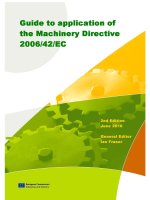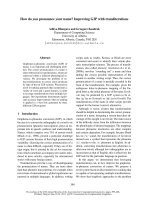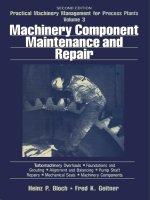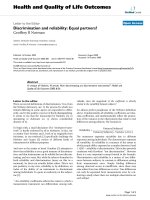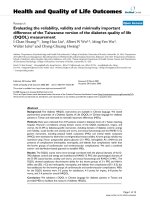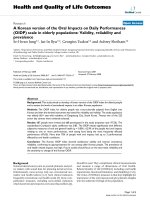improving machinery reliability 3e potx
Bạn đang xem bản rút gọn của tài liệu. Xem và tải ngay bản đầy đủ của tài liệu tại đây (19.08 MB, 710 trang )
I
HlHU
tUI
I
IU
m
Pral
II
I
VOLUME
1
I
I
I
ffl
I-
Practical Machinery Management
for
Process
Plants
VOLUME
d
THIRD EDITION
Improving
Machinery
Practical Machinery Management for Process Plants:
Volume
1:
Improving Machinery Reliability, 3rd edition
Volume
2:
Machinery Failure Analysis and Troubleshooting, 3rd edition
Volume
3:
Machinery Component Maintenance and Repair, 2nd edition
Volume
4:
Major Process Equipment Maintenance and Repair,
2nd
edition
Other Machinery Engineering Texts from the Same Author:
Introduction to Machinery Reliability Assessment, 2nd edition
Reciprocating Compressors: Operation and Maintenance
I
Practical Machinery Management
for
Process Plants
I
Improving
Machinery
Reliability
Heinz
P.
Bloch
Gulf Professional Publishing is an imprint of Elsevier Science
Copyright
0
1982, 1988, 1998 by Elsevier Science
(USA).
All rights
reserved.
Originally published by Gulf Publishing Company, Houston,
TX.
No
part of this publication may be reproduced, stored in a retrieval system,
or
transmitted in any fonn or by any means, electronic, mechanical,
photocopying, recorchng,
or
otherwise, without
the
prior written permission of
the publisher.
Permissions may be sought directly
from
Elsevier’s Science
&
Technology
Rights Department in Oxford,
UK:
phone: (+44) 1865 843830, fax: (+44)
1865 853333, e-mail:
You may also complete
your request on-line via the Elsevier Science hoinepage
(),
by selecting ‘Customer Support’ and then
This book
is
printed on acid-free paper.
~ ‘Obtaining Permissions’.
Library
of
Congress Cataloging-in-Publication Data
Bloch, Heinz
P.,
1933-
Improving machinery reliability
/
Heinz
P.
Bloch.
-
3‘d ed.
Includes bibliographical references and index.
p.
cm. -(Practical machinery management for process plants; v. 1)
ISBN
0-88415-661-3
(alk. paper)
1. Machinery-Reliability.
I.
Title.
II.
Series: Bloch,
He&
P., 1933-
Practical machinery management for process plants. 31d ed.
;
v. 1.
TJ153.B58 1998
621.8’1-dc21 98-26184
CP
The
publisher offers special discounts
on
bulk orders of this book.
For information, please contact:
Manager of Special Sales
Elsevier Science
200 Wheeler Road
Burlington,
MA
01803
Tel: 781-313-4700
Fax: 781-313-4802
For information
on
all Gulf publications available, contact our World Wide
Web homepage at
10
9 8 7 6
5
4 3
2
Printed
in
the United States of America.
Contents
Preface
x
Introduction
xx
1
Requirements Specification
1
Industry Standards Available for Major Machinery in Process Plants,
1;
How to Deal with the Typical API Data Sheet,
2;
Narrative
Specifications Lead
to
Better Machinery,
15;
Considering Uprateability
and Low Failure Risk, 21; Auxiliary Systems for Turbomachinery: The
Systematic Approach, 24; Dealing with Deviations from the
Specification, 34; Specifying Machinery Documentation Requirements,
37; Conclusion,
5
1
2
Vendor Selection and Bid Conditioning
53
Selecting Major Machinery Vendors, 53; Applying and Reviewing
Machinery Reliability Improvements Derived from Modern
Electronics, 54; Selecting a Pump Vendor, 64; Bid Tabulation and Bid
Conditioning: An Overview, 76; Reference, 8
1
Audits Versus Reviews,
82;
Where to Concentrate Audit and Review
Efforts,
82;
Rotordynamic Design Audits, 83; Auditing and Reviewing
Centrifugal Compressors, 125; Auditing and Reviewing Steam Turbines,
135; Evaluating Major Reciprocating Compressors, 139; Reliability
Review for Centrifugal Pumps, 146; Significant Differences in Bearings
and Bearing Housings, 156; Marginal Lubrication: A Factor in Pump
Failures,
160;
Applying Roller Bearings
in
Centrifugal Pumps, 168; How
Much
Oil
Is
Enough?, 171; Bearing Selection Can Make a Difference,
172;
Air
Cooling Provisions for Bearing Housing-How
Good?
173;
Stuffing Box Cooling
Is
Not Usually Effective, 174; Pumps for Handling
Entrained Gases, 176; Selection Criteria for Zero Emission Pumps, 178;
Design Appraisals for Special-Purpose Gearing, 18 1; Evaluating Cooling
Tower Fans and Their Drive Systems, 200; Reliability Reviews
in
Uprate
Situations, 203; Reliable Shaft-Hub Connections for Turbomachinery
Couplings, 213; How to Keep Track of Reliability Review Tasks,
224;
Machinery Reliability Audits for Existing Plants, 224; References, 238
3
Machinery Reliability Audits and Reviews
82
V
4
Maintenance and Benchmarking Reliability
.
.
.
. .
.
.
.
242
Maintenance Measurement, 242; Organize to Manage Reliability, 249;
Maintenance Cost vs. Replacement Asset Value: Another Maintenance
Spending Benchmark, 257
5
Life Cycle Cost Studies
. .
. . .
. . . . . . .
.
,
.
. .
.
.
.
.
. . .
.259
Simplified Life Cycle Cost Estimating, 259; Life Cycle Cost
Assessment: The Rigorous Method, 272; Summary,
3
10;
References, 3
10
6
Extending Motor Life in the Process
Plant Environment
.
,
.
.
. . .
.
.
.
. .
.
.
. .
.
,
.
. . .
.
.
.
. . .
,313
Squirrel-cage Motors Are Most Prevalent, 3 14; Motor Insulation
Systems, 3 14; Insulation Classification, 3 15; Ambient Plus, 3
15;
A
Bank of Motor Life, 3 17; Running Cooler-A Relative Term, 3
18;
Thermal Cushion, 3 19; Enclosures, 3 19; Standard,
but
Different, 3 19;
Learning from Failures, 320; More about Thermal Loading, 320;
Economics of Oversizing, 321; Keep Bearings
in
Mind, 323; Motor
Mounting Basics, 325; Motor System Tuneup, 326; Pumping and
Piping, 326; Power Points, 326; Over-Current Insurance, 327; Motor
Life Insurance Terms, 328;
Notes,
328
7
Equipment Reliability Improvement through
Reduced Pipestress
.
. .
. . . .
,
.
.
.
,
. .
. . .
,
m
.
.
. . .
,329
Allowable Load, 33
1
;
Excessive Flexibility, 333; Theoretical
Restraints, 334; Expansion Joints, 335; Other Practical Considerations,
337; References, 338
8
Startup Responsibilities
.
.
. . .
m
.
.
. .
.
. . . .
.
.
.
.
.
.
.
.339
Summary
of
Startup Preparations for Process Plant Machinery, 339;
Machinery Startup Review Tasks, 342; Machinery Startup Reporting
Structure, 344; Documentation for Effective Tracking of Progress, 348;
Vendor Assistance and Outside Facilities, 359; Consultants
and
Contract Assistance. 359
9 Spare Parts and Their Effect on Service Factors
. . . .
361
Spare Parts Philosophies, 361; Spare Parts Storage and Retrieval, 361
;
Spare Parts Documentation, 363
10 Maintenance for Continued Reliability
.
.
.
.
.
,
. . . .
.
.
.
365
Modern Maintenance Approaches and when
to
Apply Them, 365;
Maintenance Management Options, 374; Detailed Task Descriptions
vi
Improve Maintenance Effectiveness, 380; Machinery Turnaround
Planning, 394; Turnaround Scope Development through Reliability,
Availability, and Maintainability Analysis, 401
;
Effective Maintenance:
Preventive or Predictive?, 41 6; Preventive Versus Predictive
Maintenance for Typical Centrifugal Pumps, 421; How
to
Be a Better
Maintenance Engineer, 429; The Role of the Maintenance Engineer
in
the Knowledge Age, 43
I;
References, 432
11
Maintenance Cost Reduction
.434
Eliminating Cooling Water from General-Purpose Pumps and Drivers,
434; Economics of Dry-Sump Oil-Mist Lubrication for Anti-friction
Bearings, 440; Gear Couplings Versus Non-lubricated Couplings, 45
1
;
Elastomeric Couplings, 457; Quantifying the Reliability Impact of
Laser Alignment Techniques, 461
;
Quantifying Impact, 470;
Why
and
How
to
Monitor Centrifugal Pump Condition, 477; References,
483
12 Lubrication and Reliability
.485
Methods and Criteria for Lube-Oil Purification, 485; Cost Justification
and Latest Technology for the On-Stream Purification of
Turbomachinery Lube Oil, 49
1
;
Synthetic Lubricants and Reliability
Improvement, 503; Vibration Performance Improved with Synthetics,
5
15; Automatic Grease Lubrication as a Reliability Improvement
Strategy,
517;
References, 525
13
Providing Safety and Reliability through Modern
Sealing Technology
,527
API Standard 682,528; Low-Emission Single Seal Design, 531; Dual
Seal Arrangements, 543; Compact Gas Seal Technology for Pumps,
550;
The
Reliability Impact of Special Seals for Non-Pump
Applications,
558;
Specialty Seals for Non-Pump Applications,
565;
Dry
Gas
Compressor Seals, 58
1;
Warding off Equipment Reliability
Setbacks:
A
Postscript, 593; References, 598
AppendixA
600
Useful and Interesting Statistics
AppendixH
.609
Common Sense Reliability Models
Index
668
vii
Most
of
today’s process plants proudly display a Company Vision
statement. Sadly, relatively few pursue the kinds of action needed to
reach their often lofty visions. Conversely, it should be clear to
us
that a
serious company will take steps
today
to identify and implement the sci-
ence and technology “investments” necessary for modern petrochemical
plants to remain competitive into the
next
decade and beyond.
Based on my observation or perception of trends among the trendset-
ters and the forward thinking of the “Best-of-Class” companies,
I
would
like to
alert
the
reader
to
a
few
of
the work processes, organizational
realities, lineups or interfaces, as well as hardware and software systems
that have been implemented
by
the most profitable process plants in my
career, dating from the
1960s
to the present.
I
will summarize by giving a few important explanations. First, none
of the items
I
highlighted in this third edition were concocted for the
sake of compiling
a
wish list of far-fetched goals. Every one of the vari-
ous
observations and recommendations either reflects current practice or
has been implemented by one or more plants in the United States or
overseas.
Second, no single plant presently applies or implements all the recom-
mendations or practices given here. It
is
nevertheless of real importance
to acknowledge that some companies come surprisingly close to practic-
ing these reliability concepts or will soon implement them. The future
belongs to them.
Third,
it
may not be realistic
to
expect every company
to
have the
same priorities for implementing what is perceived to be the ideal path
toward high reliability and profitability. However, it would be equally
unrealistic to assume that a company can pick and choose from
a
smor-
gasbord
of
easy items and forget about the politically difficult ones. Mea-
suring up to tough competition will require an uncompromising and sin-
gle-minded desire
to
pursue excellence. Paying lip service
to
reliability
and profitability concepts without implementing the difficult and some-
times unpopular steps necessary to get there is
a
costly exercise
in
futility
and is doomed
to
failure.
viii
Finally,
we
should a11 recognize the interwoven relationship of
so
many of the requirements and issues. It is important to realize that we
can logically hold someone accountable for quality and solid perfor-
mance only after training that person. Progress implies change. Change
implies risk and extra effort to manage the risk. We can better justify,
specify, purchase, install, operate, and maintain process plant machinery
only
if we invest time and money up front in reading and learning about
best available practices. That, of course, is what this book is all about.
Many
of
my colleagues in process plants, machinery manufacturing
facilities, or in the consulting field are practitioners
of
the various relia-
bility improvement or assurance approaches. And for allowing me
to
include some of their work in this revised and updated text, sincere
thanks
go
to Paul Barringer, whose work on life cycle costing and relia-
bility assessment
is
truly unique; Lou Bewig for some excellent work on
benchmarking; Gary Bostick (Woodward Governor) for a concise write-
up
on
modern turbomachinery controls; R. Ellis and M. Galley (Dow)
for
documenting task descriptions used in best-of-class maintenance;
Galen Evans (Ludeca) for quantifying the reliability impact of laser-
optic alignment issues;
s.
Gupta and John Paisie (Sun Oil Company) for
groundbreaking work on the value-related definition of turnaround
scope; Bill Key (Flowserve), W. Schoepplein, and J. Nasowicz (Dich-
tungswerke Feodor Burgmann), Bill Adams,
W.
Binning, and R. Phillips
(Flowserve), Jim Netzel and P. Shah (John Crane) all of whom con-
tributed lucid material on modern sealing technology; John
s.
Mitchell
for his always authoritative and equally compelling summary of the
direction in which maintenance efforts must be channelled in the twen-
ty-first century;
L.
C.
Peng for his contribution on pipe stress issues;
Jean Revelt (Lincoln Electric) for neatly explaining important reliability
aspects of electric motors;
R.
Ricketts (Solomon Associates) for shed-
ding considerable light on rigorous benchmarking; and
to
Paul Smith for
his observations on the “knowledge worker” who is certain to be needed
to deal with reliability issues from this day on.
Their contributions and those of others whose personal and/or compa-
ny names are mentioned in footnotes and captions are gratefully
acknowledged.
Heinz
P
Bloch,
I?
E.
ix
Introduction
The View
of
an Advocate
for
Change*
Machinery reliability management in the process industries can be
divided into three phases: equipment selection and pre-erection reliability
assurance, preparation for effective startup, and post-startup reliability
assurance and maintenance cost reduction. All of these phases are impor-
tant; they are intertwined and merit equal attention. The techniques and
procedures described in this text cover essential elements of each phase;
they have been critically examined and have led to substantially
improved reliability and maintenance efficiencies. Adoption of applica-
ble techniques and procedures at your plant is certain to result in similar
benefits.
In the quest for increased reliability, multiple dimensions must
be
con-
sidered.
The first is whether maximum profitability for a given enterprise and
maximum reliability are one and the same. Recent interviews with expe-
rienced individuals indicate a growing awareness that business-operating
and profit models often change dramatically with time and other factors.
The latter include status of product sales (sold out or not sold out), level
of inventory, alternative sources, and facility design life. The funds nec-
essary to maintain and improve reliability must fit profitably within the
enterprise business model.
Next are the methods and practices that must be established and main-
tained
to
assure optimum reliability.
Good
design and installation prac-
tices, improved components and materials, condition-directed mainte-
nance, root cause identification and correction are the subjects dealt with
in this book. All are vital and must be addressed. Success demands more
than awareness. Acceptance and top-down commitment to optimizing
reliability are mandatory.
*Contributed
by
John
S.
Mitchell,
San Juan Capistrano, California. Adapted by permission.
X
Organizational and administrative aspects of every function must be
streamlined and optimized. In the reliability area this means bringing
maintenance and operations closer together in a supportive partner rela-
tionship rather than the common adversarial hierarchical organization.
Finally, information creation and effective communications are essen-
tial
to
measure performance, assure conformance to enterprise objectives
and best-of-class benchmarks. Within a typical enterprise there are at
least four classifications of information. Senior executives require infor-
mation such as costs-per-unit output and production availability. At the
MRP
(manufacturing resource planning) level, long-term prediction
of
equipment lifetime-the ability to meet contractual obligations-is
essential. Operations must have detailed, real-time knowledge of equip-
ment condition and any immediate threats to production. At the detail
level, condition assessment, maintenance management, and information
systems must function together. Tasks include gathering and managing
data, creating and exchanging information as well as directing appropri-
ate information to other levels in the organization. Accomplishing this
ambitious, crucial objective requires generically open systems and a
common method of communications.
In many industrial enterprises, senior management appears to be grow-
ing increasingly aware that maintenance and reliability improvement, or
more broadly, lifetime asset management, is the “final frontier” of maxi-
mizing profitability. Thus far, most of the focus seems to be
on
reducing
costs by re-engineering the administrative process and eliminating per-
sonnel. Requirements for real
SUCC~SS
include awareness that mainte-
nance and reliability improvement are strategic contributors to income
and profitability. Investment to optimize reliability and reduce the need
for maintenance
is
imperative. From a strategic perspective, maintenance
cost reduction
is
a
result-not an action.
Optimized practices such as pre-procurement equipment reliability
audits, installation reviews, and condition-directed or predictive mainte-
nance have been in
use
since the
1960s.
All
have proven highly effective
toward improving availability and reducing unexpected failures and
costs. Unfortunately, results have not been communicated effectively
in
financial terms to senior management.
As
a consequence, many
SUCCCSS-
ful
condition-directed maintenance programs are being curtailed or, in
some cases, terminated altogether as cost cutting measures.
Are arbitrary cost reductions and changes for change sake the way
to
greater maintenance efficiency? In most cases the answer
is
no.
Arbitrary
xi
downsizing, eliminating proven programs such as condition-directed
maintenance to end the ongoing operating cost may well have the oppo-
site effect-reduced availability, reduced efficiency, and increased main-
tenance costs.
The answers are in three areas: value, organization, and information.
These issues are addressed in the text.
Reliability improvement and maintenance activities must be reoriented
from
a
cost-centered to
a
value-
or
profit-centered mentality. Within a
cost-centered framework there are no incentives for improvement. In fact,
there are disincentives for improvement! Everyone knows what happens
if
a maintenance budget is underspent and how those responsible for the
achievement are rewarded. “Spend it or lose
it”
is
known to all. As a
result, many expenditures occur at year end-some unwise-to make cer-
tain budgeted funds are all spent. It would be far better
to
shift to a value
orientation that encourages continuous improvement and rewards
increased effectiveness.
Many leading enterprises are shifting to multi-functional team-based
organizations. Benefits include single-person accountability for a readily
identifiable process or area, pride of ownership, and elimination of coun-
terproductive trade mindsets.
Success with the necessary changes requires enabling technology.
Technology includes designing in reliability, designing out maintenance,
and implementation of productivity-improving information systems that
make the remaining maintenance tasks easier and more efficient. Plan-
ning, scheduling, tracking workflow, and providing time, materials, and
cost information are vital functions of computerized management and
information systems. Technology is indispensable for condition assess-
ment and for clearly conveying equipment status to operators, mainte-
nance, and production planners. Technology also plays a vital role
in
assembling and communicating planning and performance information,
value and benefits to senior executives and financial managers.
There must be an overall vision or concept that unifies individual
changes into an optimized whole fabric. Profit-centered maintenance, the
first stage in the unification process, establishes value as the prime objec-
tive. Value is achieved by maximizing quality, efficiency, and commer-
cial availability while permanently reducing the need for maintenance.
Add an optimized organization and crucial information made available at
every level of the organization and the result is value-driven asset man-
xii
agementl-a totally new concept for achieving maximum value from
industrial production and manufacturing assets.
Asset Management and the Maintenance Process.
Industrial
production and manufacturing equipment are the specific assets of inter-
est to reliability and maintenance professionals. Machinery, solids-han-
dling equipment, heat exchangers, valves, etc. are examples. Vital
integrity tests and condition-assessment measurements include mechani-
cal and fluid condition, operating efficiency, safety checks, operational
and electrical tests, thickness, and cathodic/anodic voltage measure-
ments, temperature profiling (thermography), and leak detection. The
preceding examples and others form the basis of asset management.
There
is
one incontestable law of maintenance: The only way to per-
manently reduce maintenance cost is to
reduce the need
for
maintenance.
Examples of this principle are as close as our television. Many of today’s
automobiles advertise a guaranteed
100,000
miles between tune-ups.
How have maintenance requirements been reduced
so
dramatically-by
at least a factor of
20
in the past ten years? The answer is clear: Design
for least maintenance. That means better materials, fewer parts, greater
attention to lubrication, and extensive use of low-maintenance compo-
nents such as fuel injection and electronic ignition. Trends in the automo-
bile industry demonstrate that reduced maintenance has real value. There
is
another law of maintenance familiar to television viewers: mainte-
nance neglected or ignored always reappears-multiplied in cost and
effect. “Pay me now cur pay me much more later.”
Another bit of wisdom bears repeating: Many senior business and
financial executives fail to recognize high availability, normal operation,
and the absence of problems as direct results of continuing action. Exam-
ples include continuing action by conscientious, committed individuals
and systematic programs such as cost-justified equipment improvements,
condition-directed maintenance, and proactive problem solving. In some
cases, successful maintenance programs are curtailed or even terminated
because high availability and fewer problem incidents lead to
the
conclu-
sion that benefits have been largely captured and thus the means
employed to gain these results are no longer necessary.
For the past several years, reliability has been the primary focus of
maintenance professionals. However, as most are aware, reducing load
and the rate of production increases reliability. But is reduced production
an option? If not, perhaps reliability is not the final objective. Reliability
xiii
is a maintenance-oriented objective and the means to an end-but per-
haps not the end itself. The ability to operate when required at specified
production output and quality while gaining maximum value is an out-
ward objective directed to the success and well- being of the enterprise as
a
whole. If this conclusion
is
true, perhaps processes and priorities
should be reviewed and reconsidered.
The concept of value leads to equipment selection and maintenance
prccesses that
look
outward and are results oriented.
As
this text will
demonstrate, overall characteristics include:
design for reliability and maintainability
require best-practice installation
identify and correct root-cause deficiencies
eliminate chronic problems
invest for continuing, value-directed, permanent improvements
create value-oriented measures of performance
conduct continuing workforce training
monitor and test to verify condition and assess and measure results
report value gained to senior management in credible financial terms
establish and maintain a process of continuous improvement
that
compel support
All the preceding are directed to gain maximum value. Prioritization
and careful consideration of production availability requirements and life
cycle cost are mandatory. With this philosophy, sacrificing the future for
short-term gain is a relic of past inefficiencies.
Specific examples in the machinery area include:
select components and materials for an optimum balance between
properly level and attach baseplates to the foundation; properly align
provide easy access
to
components requiring maintenance; avoid
assure quality lubrication, exclude contaminants, perhaps by utilizing
production availability and
life
cycle
cost-not just least cost
piping
interfering with efficient removal and reinstallation
oil mist
xiv
*
maximize condition directed maintenance
eliminate unnecessary scheduled maintenance
*
employ situational use of operate-to-failure
0
employ precision balancing and alignment; include comprehensive
alignment training
0
eliminate overrepairs
0
require post-repair quality assurance such as motor testing under load
0
increase common spare parts, e.g., impellers, shafts, bearings, cou-
plings
The change in philosophy and perspective necessary
to
gain maximum
value from maintenance must be driven from the very top of an enter-
prise. And this likely requires education. Education for plant manage-
ment, senior corporate, and financial management
is
necessary to illumi-
nate the potential and benefits to be derived from optimized
maintenance. Education should focus on ways
to
build the compelling
vision of
how
equipment-asset management can and must contribute
to
twenty-first century success.
Profit-centered maintenance2
is
a name given to
a
concept constructed
around creating value. Profit-centered maintenance has the following
attributes:
e
a mindset, not an accounting method
*
oriented
to
create greatest value-not least cost
e
addresses physical, administrative, and organizational processes
*
uses enabling technology to the fullest
e
addresses the relationship between maintenance and other functional
areas
Profit-centered maintenance is a continuing, regenerating process.
It
includes
a
combination of life cycle optimized, value-oriented design,
root-cause ildentification and correction, proactive, condition-directed,
scheduled and reactive maintenance, and streamlined administration. All
are assembled to create maximum value and operating profitability.
xv
There are numerous benefits to be gained by adopting profit-centered
maintenance. The central benefit is the concept of value that drives the
entire process to new levels of maintenance effectiveness.
Implementing profit-centered maintenance requires
a
long-term, life
cycle perspective and a commitment and willingness to invest for the
identification and root-cause correction of deficiencies. These are aimed
toward life extension and reduced life cycle costs
by permanently
decreasing the need
for
and
cost
of
maintenan~e.~
At each step along the
way it is imperative to formulate and communicate credible financial jus-
tification and results of profit-centered maintenance to senior executives
and financial management.
Condition assessment, condition-directed maintenance, and proactive
problem avoidance are vital elements of profit-centered maintenance.
Much has been written about condition assessment and condition-direct-
ed maintenance;
only
the crucial value or profit-centered principles will
be repeated here. These include:
The mix of maintenance types, e.g., reactive, preventive and condi-
tion-directed, is determined by value considerations. Some machines
are most profitable run-to-failure. Others require full condition
assessment and condition-directed maintenance for highest profitabil-
ity. For most, greatest profit requires a balanced mixture of preven-
tive and condition-directed maintenance.
Detailed, diagnostic mechanical condition assessment from vibration
and fluid (lubricating and hydraulic oil) characteristics, electro-
mechanical condition from static and dynamic electric (current) char-
acteristics, internal wear, buildup and erosion from operating perfor-
mance and efficiency and external conditions (leaks, loose fittings,
unusual sound and smell) are all necessary for
a
complete, accurate
picture of condition.
Method of condition assessment, type and number
of
measurements
and interval between successive measurements must be based on sev-
eral factors. These include optimum methods to assess condition and
provide earliest detection of change, current condition, rate
of
change, and the probability and consequences of failure. Anticipated
time between discovery of a potential failure and requirement for cor-
rective action
as
well as operating/production requirements and value
are other important considerations.
xvi
0
Condition assessment must be directed toward increasing commer-
cial availability and reducing operating costs. Measures such as
number of machinedpoints monitored and average vibration level
are irrelevant and inconsistent with the principles of profit-centered
maintenance.
Full, enthusiastic support from Operations/Production is a mandatory
aspect of profit-centered maintenance. Contrasted with re-engineering, a
one time radical change to organizational and administrative processes,
profit-centered maintenance addresses all elements of the maintenance
process: equipment, organizational, and administrative and
is
a process
of continuous change.
It
is
value-centered and has a broader scope than
condition-directed maintenan~e.~ Profit-centered maintenance demands
proactive, preemptive maintenance, and requires continuous evaluation,
refinement, and improvement.
Profit-centered maintenance is a powerful statement of commitment to
the principal corporate objective. It is focused on outward, customer-ori-
ented results. Profit-centered maintenance leads to optimum decisions
and permanent solutions that maximize profitability.
Organization.
Many leading visionaries are shifting to team-based,
multifunctional organizational structures with overall responsibility for a
logical, readily identifiable process or area.5 This concept has numerous
advantages over traditional “silo” organizations based on functional work
groups. Characteristics of the team organization include single-person,
end-to-end responsibility-including logistics and quality-and assign-
ment of all
skills
necessary for normal operation. Benefits include greater
awareness, ownership, involvement, responsibility, and improved team-
work. Counterproductive bickering and operating costs are diminished.
Specialized, high skill and safety-related tasks and training remain within
a central support organization. Examples include high voltage electrical
testing, in-shop machine work, specialized repairs and training in areas
such as instrument calibration, pump seal replacement and shaft align-
ment.
As
an example of how this concept is implemented, one facility
allows cross-trained mechanics to tag out, disconnect, and remove a
motor for repairs. Electrically reconnecting the motor requires
a
qualified
electrician.
xvii
Shifting to this new form of organization requires
a
willingness and
commitment to empower personnel and relinquish traditional hierarchi-
cal control.
Ingredients for success include:
incentives that are entirely based
on
team success
a
encouraging ownership, initiative, and responsibility; demanding
developing, encouraging, and supporting extraordinary performers
promoting competency; penalizing mediocrity
substituting initiative and flexibility for inefficient, counterproductive
accountability
trade-and-craft mindsets
Some facilities may find the transition to a full-team organization too
formidable to accomplish in
a
single step. Several in this position have
used other measures to achieve comparable results.
A
number of compa-
nies reported outstanding results and greatly improved cooperation by
simply having maintenance and operations/production managers
exchange positions. One site found that transferring responsibility for
the maintenance budget to operations proved exceptionally valuable
toward establishing a cooperative relationship.
Recognize that massive change to a team-based organization may be
opposed, both overtly and covertly by people who depend upon and feel
more comfortable within
a
less challenging, traditional hierarchical orga-
nization. Recognize also that unless change of this scale is presented and
implemented with
a
great deal of sensitivity, the very people needed most
for success can be lost.
Information Systems6
These systems glue the fabric together. In pro-
duction and manufacturing enterprises at least five layers of operating
information can be identified-each with specific requirements:
Information describing the current and projected condition of produc-
tion equipment is vital. The threat and timing
of
potential problems
and components affected must be communicated to production and
maintenance planning. Recommended corrective action for optimized
work scheduling and planning are vital elements of
the
asset manage-
ment process. Requirements and completion records for safety and
xviii
operational tests, equipment condition assessment, calendar or time-
based maintenance, integrity tests for components such as safety and
relief vahes, corrosion thickness, cathodic and anodic protection
voltage measurements and reliability records are examples
of
other
information that must be readily available.
*
Work process information is also quite necessary for optimized,
value-directed maintenance. Some facilities have developed com-
plete, verified instructions for every maintenance task. These instruc-
tions include safety procedures and precautions, parts and tools
required,
a
step-by-step procedure to accomplish the task and unique
task-specific considerations. In addition to greatly improving produc-
tivity, detailed instructions substantially reduce mistakes that result in
post-repair failures.
0
Supplying refined condition-assessment results
to
operations for dis-
play on the process control system is another much needed improve-
ment. Better, more informative displays create a greater awareness
of
condition and the operating variables that influence condition. Confi-
dence
to
initiate action if difficulties arise and the ability to contribute
observations pertaining to variations are added value gained by ready
access to easily interpreted condition information.
Refined, easily interpreted, actionable information to operations/pro-
duction planning and maintenance management systems is equally
important. Contrasted with operators, these users need predictive con-
dition-assessment information for medium and long-term planning.
Will production assets be available to meet future contractual com-
mitments? The information required includes equipment status, prob-
lem identification, classification, severity and rate of change, compo-
nents affected, time to required action and recommendations for both
Operating and repair
action^.^
The timing and length of an optimized
production outage, spare parts and personnel requirements are con-
structed from this information.
e
Benchmark measures such
as
mean-time-between-repair
(MTBR)
and availability are valuable management information. Information
required for executive and financial management includes cost-per-
unit output, return on assets, life cycle costs, and operating profitabil-
ity. These, and other measures, are needed to measure effectiveness,
convey value, and justify the ongoing cost of the processes and peo-
ple creating value. If performance measures trend opposite to require-
xix
ments, information must be available to identify whether specific or
enterprise-wide solutions must be implemented.
The ability to assemble vital management reports automatically is a
crucial requirement of an information system. An expert should examine
crucial information prior to transmittal and have the opportunity to add
interpretation and editorial comments. However, the expert should not
have to perform manual data gathering. The days when time was avail-
able to compile information from multiple sources and correlate it manu-
ally for management reports
is
long past. Reports must be self-generat-
ing, or at least all information must be available for report generation.
The traditional method
of
displaying measurements must be improved.
Begin with a definition of information-it must be understood. Most
process control professionals state that information conveyed to opera-
tors should be limited to that requiring action within a relatively short
time period, typically a shift. Most also agree that conveying long-term
threats and too much description to operators, for example, outer race
bearing failure probable within
a
week or month, is irrelevant, distract-
ing, and potentially counterproductive.
A
case can be made that differen-
tiation between specific failure types
is
relevant to an operator only if
it
affects action required. Too much long-term information may create an
indifference that ultimately results in missing a real requirement for
immediate action.
Information must be displayed in a clear, understandable fashion. Indi-
vidual measurements, such as vibration expressed in engineering units,
and even measurement-versus-time trends do not meet requirements if
too much skilled interpretation is required. Expert decision advisory sys-
tems will occupy
a
vastly expanded and important function in the data-
to-information-conversion process. Expressing complex data
as
a single
measure of machine life remaining, or as a normalized condition index
has been ~uggested.~ Information displayed in a friendly form such
as
a
smiling face has far greater value and impact than values and even
trends. Not surprisingly, there is
a
scientific basis for smiling faces and
other imagery used to translate complex multidimensional measurements
into an easily interpretable form.8
xx
Information
Exchange.
This is a vital
issue.
There are three basic
alternatives for information exchange. Many large corporations imple-
ment single-supplier, facility-wide information systems that include
accounting, financial, personnel, operations, and maintenance. Others
accomplish a custom integration to connect information components and
practices currently in use within the enterprise.
A
third alternative
employs self-integrating open systems that enable an enterprise
to
pick
components that are best for their specific application with assurance
of
interoperabili ty.
The single-supplier structure has the advantage of defined accountabil-
ity. Disadvantages include total reliance on
a
single supplier and the dif-
ficulty of duplicating and maintaining levels of excellence equivalent
to
specialized, applications-specific information components within
a
single
source system. The crucial question is whether an information system
designed primarily for one purpose can be efficiently extended to accorn-
modate the facilities and rich detail necessary to gain maximum value
in
specialized areas such as condition assessment, lifetime prediction, an
condition-directed maintenance. And if not, how are these vital tasks
incorporated into the overall architecture?
Integrating information components that are in use within an enter-
prise has the advantages of familiarity and presumably adequate perfor-
mance for the tasks. Disadvantages include the hazards
of
institutional-
izing current practice, which may not be best practice, and the high-cost,
one-time, specialized nature of component integration. The necessity to
redo all or part of a system integration in order to gain the benefits of
advances in experience and technology
is
another potentially costly dis-
advantage.
3elf integration, the
so
called “plug-and-play” open system has numer-
ous advantages for enterprise information systems. Users can select com-
ponents that are best for their specific application with assurance of full
information exchange. System components and information can migrate
to best-practice improvements at least
cost
as
experience
and
technology
increase. The personal computer model is instructive. Low-cost word
processing, ready exchange of information between applications, and
the
current proliferation of
CD-ROMs
for multiple uses would not have
occurred without a standard platform and open information exchange
conventions.
xxi
Some areas, notably process control, are moving quickly in the direc-
tion of fully open systems. However, for asset management and mainte-
nance the open systems solution has not
yet
developed. Why is this?
Many maintenance professionals believe the challenge is insurmount-
able. Others believe there cannot be any departures from current work
processes that may be unique to
a
single site. Suppliers may believe that
maintaining absolute control over their portion of the information struc-
ture and all gateways in and out is to their commercial advantage. Many
of these arguments appeared when process control transitioned from
analog to digital systems twenty or
so
years ago. Ultimately, control sys-
tem purchasers realized that open systems were
the
only way to achieve
maximum performance at an affordable cost. Asset management and
maintenance are not well served by going through the same process.
There is movement toward open systems in the maintenance and asset
management areas. The activity accomplishing this valuable objective is
called MIMOSA, the Machinery Information Management Open Sys-
tems Alliance.'o.
I
I
In summary, gaining maximum value from process, production, and
manufacturing equipment requires
a
comprehensive, value-oriented
process that begins at design and extends through operation. Vital ingre-
dients include continuing, well-planned machinery reliability enhance-
ment, maintenance optimization, and life-cycle cost justification. Within
this process, maintenance must be directed toward eliminating problems
and safely reducing the need for maintenance. Perceptions must change.
Improving equipment reliability at the very inception of a project,
demanding quality during installation, and focusing on lifetime equip-
ment management must be accepted and applied. Now
is
the time to
drive the change process to your advantage.12 The future is not very
promising for enterprises that are significantly below competitive best.
This completely revised edition focuses on some of the most important
and highest return-on-investment methods, work processes, and tech-
niques for your move toward competitive best. This
book
starts by show-
ing the reader how to gain maximum value from manufacturing equip-
ment. Not
a
bad place to start!
xxii


